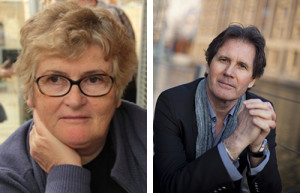Marie-Eve Joël and Jean-Marie Robine
present the Longévité et Vieillissements [Longevity and ageing] research cluster

The economist Marie-Eve Joël, senior professor at the University of Paris-Dauphine, and the epidemiologist Jean-Marie Robine, senior researcher at INSERM, co-direct the Longevité et Vieillissements research cluster, which has just launched a website.
(Interview conducted in May 2015)
The Longevité et Vieillissements research group was created in January 2014—for what purpose?
Jean-Marie Robine: This research cluster (Groupement de Recherche or GDR) was a combined initiative of the Ministry of Higher Education and Research and several research institutions, including the CNRS, INED, INSERM, University of Paris-Dauphine and the Caisse Nationale d’Assurance Vieillesse (CNAV), France’s national retirement pension fund. Our main objective is to promote visibility for human and social science (SHS) research teams working on ageing.
According to CNAV figures, there are nearly 400 SHS researchers in France who study population ageing. Those teams, studying a reality that has become a research priority at both the European Union and intergovernmental levels (Horizon 2020, Joint Programming Initiatives), are not at all clearly identified—even to each other.
Marie-Eve Joël: French teams are too scattered to be able to direct large European projects, projects now designed to respond to major “challenges” and calling for a multidisciplinary approach. That approach is still too seldom found in humanities research in France. Researchers interested in ageing do not really know each other and are not used to working together.
How does the GDR work to achieve its objectives?
MEJ: The GDR facilitates contacts and knowledge sharing between researchers and informs on European projects. It is a coordinating structure that runs primarily on material contributions from the founding research teams. We have a new website, hosted by INED, a newsletter called “Recherche sur le vieillissement” [Research on ageing] set up by the CNAV, and a directory. The aim is to create a genuine portal on ageing in France.
The GDR also organizes half-day research workshops around methodology and particular topics—six of them this year. Everyone brings their particular competencies. At Dauphine, for example, we held a day around SHARE (Survey of Health, Ageing and Retirement in Europe) and have designed a major European survey (the latest wave comprised 60,000 persons in 20 countries) on the economic, social and health dimensions of ageing in Europe.
JMR: As indicated by the plural term “vieillissements” [types of ageing] in our name, the GDR focuses on both structural population ageing, which is of particular interest to economists, and individual ageing. It was jointly founded by approximately a dozen research teams, that is, 150 researchers in four disciplines: demography, epidemiology, economics and sociology. We are now open to all research laboratories in these disciplines as well as teams working in anthropology, geography, psychology, law and other disciplines.
What are some of the new avenues of research on ageing?
MEJ: Retirement, to begin with, which has been studied extensively, and the health of older people and persons in the process of losing their autonomy. A major area is the economics of chronic disorders. Many questions arise. For example, how far should medicalization go? Should care provision be on an individual or collective basis? What about the situation of caregivers? We are just starting to realize the extent of inequalities in the ageing process, which remain to be explored. We used to speak of old persons’ dependence, as if everyone experienced the same type of ageing. In fact, only a small number of older persons become dependent. Like healthcare arrangements, life courses in France are highly diverse and vary by geographic area.
Ageing also affects family capital, intergenerational assistance, etc. We need to describe these new life stages, to escape overly schematic ideas or caricatures like the exhausted grandmother taking care of grandchildren and her own aged mother on one hand, wealthy seniors spending their time travelling on the other. A considerable fraction of the population will enjoy at least 15 years of good health after retirement. What place will these people assume in the social body? A considerable range of research fields are opening up, which have little to do with familiar oversimplified images or representations of old age.
JMR: We’ve been witnessing a genuine revolution in longevity. As a rule, adults live much longer now than when our modern society was first getting organized. Everything’s been shaken up. Moreover, today’s populations are more heterogeneous than ever before. Not only are they dispersed along a much wider age range, but society has never changed so quickly. People twenty years apart in age have become near strangers to each other, with extremely different histories and cultural, not to say moral, models. Perhaps what is most needed today is to gain insight into population heterogeneity, to understand what characterizes it so that we can change the way we apprehend people as subjects.
